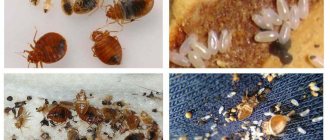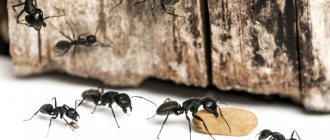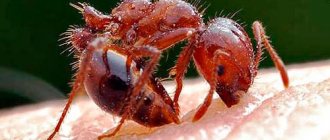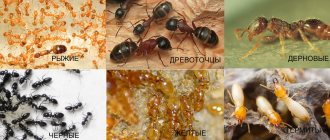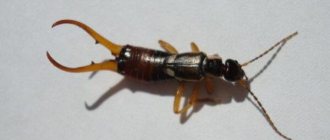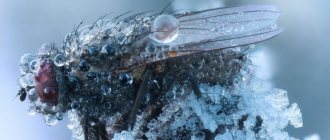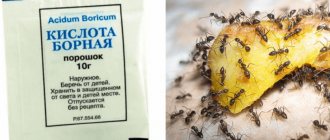Orientation in the forest using ancient signs, such as moss on a tree or the position of an anthill, will be useful for almost all travelers. For children, knowing a compass and learning how to navigate an anthill in the forest will be a fun and educational science experience.
The ability to determine the cardinal directions in natural conditions, for example, on a hike or a forest trip in search of mushrooms, can be very useful. Sometimes even the most experienced tourists get lost and look for their way home.
Ants: general characteristics
Ants are insects that live in almost all corners of our planet, with the exception of Greenland and Antarctica, as well as some oceanic islands.
They populated not only steppes and forests, but also deserts. There are 13.5 thousand species of ants, 300 of them are common in our country. Ants belong to the order Hymenoptera, phylum of arthropods, class of insects, family of ants. These are social insects, clearly divided into three castes: males, females, and workers. These little hardworking creatures cannot live alone, so they always create colonies.
Orientation by moss and lichen
Mosses and lichens do not like heat and light, so they grow in the shady side. This means that where there are mosses and lichens, there is north; on the south side there is less or no moss at all. Now orienteering on moss will not present you with any difficulties. You can also determine the direction by looking at the soil around the stone. On one side it is relatively dry (south), and on the opposite side it is wetter (north). Usually an old, rotting stump is overgrown with moss on all sides. But to determine where north and south are, you need to check the moisture content of the moss, not the soil.
Physiological features
The body structure of these insects is divided into three parts, covered with a chitinous shell: the head, as well as the chest and abdomen connected by a thin waist. The eyes, which consist of many lenses, distinguish movement, but do not produce a clear image. Ants move with the help of six thin legs with claws at the ends, which allow the insect to climb upward.
The antennae, segmented, are located on the head. These are organs of touch that not only detect odors, but also feel the vibration of the soil and the movement of air currents. The structural features of the insect and the size of the ants depend on their species, as well as their status in the colony. On average it ranges from 1 mm to 3 cm.
The largest individuals in some species are females, in others their size is no larger than the size of working individuals. Females have wings that fall off after the mating season. The colors of ants can vary from black, red, yellow and brown to unusual green or bluish. Ants are difficult to classify, since twin species and numerous hybrids are common in nature. Only specialists can distinguish them by appearance.
Orientation by mosses and lichens
This is perhaps one of the most popular ways to navigate the area. The trunks of large trees in the forest, aspens, poplars, fir, and cedars from the north are covered with various lichens and mosses due to excess moisture. Even if the entire tree is overgrown with moss, from the north its thickets are denser and wetter. This is noticeable if you examine the trunk at the bottom. On boulders, screes and kurumniks from the north of the stones you can also observe thickets of moss and lichen. These are plants that cannot tolerate direct sunlight, bright light and intense heating. The soil to the north of the stones feels wetter to the touch. Anthills are built by insects in the south of mountain slopes, trees, large stones and stumps for good heating by the sun. Ants are very heat-loving insects and carefully maintain the microclimate in the home. From the south, where the sun warms better, the anthill has a long, gentle slope. The steep slope of the anthill always faces north. The paths of heat-loving ants run from the southern side of the anthill.
How does an ant colony work?
The social hierarchy within an ant colony is often compared to the structure of a bee hive. These two species are similar in many ways, but the behavior of ants is still much more complex. Just like in human society, these insects have a strict division into classes. The anthill is designed in such a way that each mature individual has its own purpose.
Depending on a set of certain qualities, each insect is assigned to one or another social post. In this case, the personal qualities of the individual are taken into account - excessive aggressiveness, keen sense of smell, reaction speed. The hierarchy of any anthill contains the following categories of individuals:
- invaders - the most aggressive group in the anthill, attacks neighboring colonies and seizes territories;
- orderlies - isolate sick and wounded ants, if necessary, play the role of surgeons - the damaged limb is often amputated (gnawed off);
- builders are one of the largest social groups. They are engaged in repairs of premises and the external covering of the home. Throughout their life, they dig new tunnels, transport needles and twigs, and maintain the microclimate inside the anthill;
- nannies - take care of the offspring, from the appearance of the egg to the adulthood of the individual. They are constantly near the larvae, turn them over, control the process of hatching from eggs and feed the growing offspring;
- guards - are engaged in guarding the entrances and exits of the anthill; in the event of an attack, they attack the enemy and do not allow him to get inside the dwelling. Among this category there are the most losses; attacks on neighbors are common for neighboring colonies. In addition, birds and some animals like to feast on ants, and the guards never leave their posts, protecting the entrance to the last.
- foragers . The largest group in the colony. Their mission is to obtain food for the entire anthill. Every day, miners go in search of food - grass seeds, dead and weakened insects, fruits and berries. If one ant finds a large insect (caterpillar, beetle), then with the help of special signals it communicates with its fellow tribesmen, “telling” about the prey. With their combined efforts, insects can even drag a dead rodent. Attacks often occur on weakened or wounded bees, worms, and mice. From numerous bites, the victim dies and becomes food for the colony;
- shepherds . Another amazing feature of these insects is that they have peculiar pets. Herbal aphids feed on plants, and the liquid released in the process - honeydew - is collected by ants. This liquid is a waste product of aphids, has a sweetish taste and serves as a kind of delicacy for insects. The carbohydrates contained in honeydew provide the ants with energy. Therefore, aphids are collected into peculiar “herds” and protected in every possible way (for example, from theft by ants from neighboring colonies). To increase the amount of honeydew, shepherds tickle the bellies of their cows, stimulating the production of the valuable substance;
- carriers - work together with shepherds, their main task is to carry honeydew into special chambers. If necessary, engage in battle with the invaders;
- storekeepers - responsible for maintaining supplies inside the cells. They monitor the maintenance of temperature conditions and the safety of supplies. The life of the colony during the winter months depends on them, since proper conservation of food resources ensures the prosperity of the anthill;
Depending on the habitat, special “professions” appear. For example, leaf-cutter ants living in forests collect leaves from certain trees and plants. Afterwards they are transferred to the anthill, twisted in a special way and used to grow mushrooms, which are one of the main products in their diet.
Interesting fact: in some species, the profession is genetically predetermined, which is reflected in the structure of the ant’s body. And in other species, the profession is acquired by individuals gradually and they are able to replace each other’s functions if necessary.
Orientation by the sun and stars
In the off-season, on spring and autumn days, the sun will rise strictly in the east and set in the west. At noon in any season, the star is in the south and every shadow points to the north. On winter days, the sun will rise from the southeast and set from the southwest. On summer days, the sun will rise from the northeast and set from the northwest.
Any traveler has an idea of the constellations of his northern sky. Today, almost every schoolchild can find the stars Ursa Major and Ursa Minor in the sky. But although tourists may theoretically know that the North Star is the end star on the tail of Ursa Minor, finding it can be quite difficult. The advice to help with this is to find the two terminal stars in Ursa Major and mentally continue the line connecting them to the bright Polar Star. Standing facing it, the tourist will look north.
Table: determining parts of the world by the sun
Forest inhabitants will help tourists navigate the terrain without a compass or map. The squirrel inhabits only hollows protected from the prevailing winds. Insect paths on tree trunks are often on the south side. Migratory birds fly north in the spring and south in the fall. In spring, the snow begins to melt on the southern slopes of hollows and ravines, and the grass here is subsequently thicker and taller. In summer, on hot days, there is lush grass on the northern side of buildings, stones, and forest edges. The soil is drier and berries ripen earlier on southern slopes.
Life of ants in an anthill
Each ant colony, regardless of species, has one or more queens. This is a large, sexually mature individual; the characteristic difference is its large transparent wings. They are necessary for searching for males; immediately after successful fertilization, the need for them disappears and they disappear.
The lifespan of a queen is from 3 to 6 years, which is almost twice as long as that of an ordinary worker. There are cases where the queen lived up to 20 years, while insects live longer in regions with temperate climates. Male drones live the shortest, their lifespan is no more than a month. After fertilization of the uterus, they are killed as unnecessary. (Learn more about how long ants live)
The fertilized queen lays eggs in the lowest and most extensive chamber of the anthill, located deep underground. And the size of an anthill underground can reach up to two meters! This is necessary to protect the offspring from predators, temperature changes and other dangerous factors.
The queen's lifestyle is different for each species. Thus, wild forest ants have several hundred young unfertilized females in their colony. After mating, females lay clutches throughout the forest, and new colonies form next to them.
The ants of a colony located next to a person always contain several dozen male drones. The overwhelming majority of the population consists of underdeveloped females. In a small colony there is only one queen, who carries out procreation.
If the conditions in a house or apartment are favorable (warm, damp, unsanitary), then the number of ants quickly increases. In this case, several new queens appear that are capable of reproduction, which enhances the development possibilities of the colony. These females do not form new colonies, but remain part of the existing one. Of course, as the number of queens increases, the spread of ants around the house accelerates.
Ways to navigate the terrain without a compass
The ability to navigate among unfamiliar places is an important quality of a modern, competent tourist. This means, first of all, not to get lost in an unfamiliar place, to establish your location in time by the sides of the horizon and geographical objects, and to find out the direction of further movement.
It’s good when an experienced instructor takes a compass on a hike; this is not always the case in unprepared groups. If tourists find themselves in an unfamiliar area without a compass, there is no need to despair. There are many ways to navigate the terrain without this device and it’s worth getting to know them.
Choosing a place for an anthill
The founder of the anthill and all its future inhabitants is the female - the queen of ants. After mating with a male, she flies away from her home to start a new colony. In wooded areas, the queen ant chooses secluded places for her nest near trees, in old rotten stumps.
Having found a suitable place, the queen digs a hole and lays the first clutch of eggs there. Having raised her first offspring on her own, the queen is no longer responsible for the further fate of the anthill. Its task is to constantly reproduce, and worker ants take care of it and future generations.
Gradually, the ants build a hill above the ground, which ensures that the upper levels of the anthill are heated from the sun. Twigs, leaves, sticks, pieces of earth - this is what ants use to build an anthill. By laying roofing material in a special way, ants protect the roof of the house from leaks and winds.
On a note!
In steppes and deserts, the anthill does not have a part rising above the ground. Strong winds and scorching sun predetermined the need to build houses deep underground.
Tree navigation
If tourists find themselves without a compass in an unfamiliar forest area, they need to look carefully at the trees. In the south, the tree crown is more luxuriant and there are significantly more leaves. The densest branches in the dense forest develop here; the sun heats them better. Trees reach out for warmth with every leaf. In the north there are much fewer leaves and branches.
The method is not absolutely correct; allowances must be made for prevailing winds, the presence of moisture, and soil types. It is more reliable to navigate along lonely growing trees than in a dense forest.
You can navigate by the bark in a birch forest; from the south it is always lighter, more elastic and thinner. Roughness and cracks, dark growths form on the trunks of birch trees from the north. Birch is a very flexible, thin-trunked tree in young forests; the tilt of the trunk will indicate the direction of the prevailing winds.
You can navigate by the cut down stump; you just need to carefully examine the annual rings on it. Where the gaps between the annual rings are larger - south, and where the rings are located close to each other - north. It’s good if you come across a clearing with cut trees along the way. Even a few stumps will help confirm your orientation assumptions.
In the forests along which tourist routes pass, there are special signs called tourist markings. They are painted on the trunks along a planned route, always from the nearest populated area.
Exterior view of the ant house
An anthill outwardly resembles a mountain of blades of grass, twigs, and pieces of soil, but in reality it is a well-organized dwelling, inside of which interesting life is in full swing. From above, the anthill structure is a cone-shaped mound with small openings-entrances. This shape is not accidental - it allows the anthill to be well warmed up by the sun, not to get wet when it rains, and to receive the necessary access to oxygen.
Over the years, the anthill grows to several meters in height. Raindrops that fall on the outer layer do not penetrate inside. The open entrances, which are guarded by a large army of soldiers, are ventilation shafts through which air constantly flows into the ant house. In the Tomsk region, scientists discovered a huge anthill 3 meters high and about 5 meters in diameter. Experts believe that this structure took about 20 years to build.
By plants
How to navigate in the forest without a compass on a cloudy day? After all, it is possible to determine the sides of the horizon by the sun only in cloudless weather. In this case, you need to take a closer look at the trees. The following signs will help you navigate correctly:
- You will notice that one side of the bark is darker in color, and the other is lighter. This feature is most pronounced in coniferous trees. The dark bark is on the north side. Its color is due to less exposure to sunlight.
- It is also necessary to focus the removal on the resin of coniferous trees. Its greatest concentration is observed on the south side. And the growth of mosses, lichens and fungi on the bark is more often observed in the northern part.
In the summer, you can take a closer look at the color of the berries. They usually ripen faster on the south side. And the part of the berries that faces north has a greenish color.
Anthill diagram
Anthill diagram
Ants always choose a place for an anthill and materials for their house carefully. The anthill itself consists of an above-ground part and an underground nest. On top it is covered with twigs and needles, which protect the home from bad weather. And even if it looks unattractive in appearance, there is a whole town inside.
Inputs and outputs
Anthill in section
Entrances and exits serve not only to enter and exit, but also perfectly ventilate the room. The strongest and largest ants guard the entrance to the anthill, covering it with their body. Before it rains, the entrance is closed to ensure that all passages and chambers remain dry.
Solarium
This is usually the upper chamber, or room. Due to its location, it heats up very quickly and ants come here to warm themselves. And in the spring, they can spread heat on their bodies, warming up the entire anthill.
Cemetery
If you go lower down the anthill, you may stumble upon piles of dead ants and garbage. All this is put into a separate cell, which is not very deep and not far from the ventilation.
Wintering chamber
Like bears, ants also hibernate to survive the harsh cold. For this they need their own den. Usually it is located somewhere in the middle of the anthill.
Storage
Ants store plant seeds in storage in case they cannot find food for themselves. Some ants take care of the food and even take it out into the sun to dry it.
Royal chambers
The queen of ants, the queen, lives in the royal chambers. Usually she is also the first resident in her colony. The queen very rarely leaves the anthill. The whole point of her life is to lay eggs.
Nursery and kindergarten in an anthill
These are chambers in which eggs, larvae and pupae are stored. Nannies are nearby all the time, because the larvae need food and round-the-clock supervision. They move them up or down the anthill depending on the weather, trying to always keep them warm and in the required humidity.
other methods
Using a nail, a sewing needle, or a piece of wire, you can make a homemade tourist compass. At the same time, you need to understand that it will point to the magnetic pole and there will be a small error. This piece of steel must be magnetized by rubbing it on wool. In one case, it can be tied on a long thread by the center of gravity, it will rotate and stop in the north-south position. In another case, a magnetized needle is placed on a dry leaf in a small pond, the needle will indicate the north-south direction.
Given all the knowledge about orienteering without a compass, you should remember that you should not use one or two methods. Use your knowledge repeatedly, test it and if several observations are correct, the group will find the right direction.
How does an ant colony work? Life of ants in an anthill
In order to understand how ants live in an anthill, let's start from birth. Once a year, males and females hatch from the eggs and are ready to reproduce; they have wings and fly away in different directions to mate. Males, after fulfilling their main purpose - fertilization, die, and females fly away in search of a place for a new colony. Having found it, the female bites off her wings in order to obtain additional nutrients and begins to actively lay eggs.
At first, hungry times await her; she survives only due to the accumulated fat layer, but then, when the first representatives of the offspring hatch, they begin to provide her and the larvae with everything they need. The ant mother mates only once, and her supply of sperm is enough for her entire long (up to 20 years) life to reproduce offspring.
These insects belong to the Hymenoptera, male individuals develop from unfertilized eggs and have a single set of chromosomes, and female individuals are endowed with a double set. In this state of affairs, daughters acquire the entire genome from their father, and half from their mother. At the same time, sisters become closer relatives to each other than daughters to their mother. Despite the fact that the word "ant" is masculine, all worker ants are female - daughters of the queen who cannot mate and remain unfertilized throughout their lives.
Ants and their larvae
Ant social strata
Ants, like humans, have social relationships and hierarchies. Everyone has a set of qualities: intelligence, aggressiveness, reaction speed, enterprise, the ability to communicate with others. Depending on which qualities dominate in each, the ant receives a certain profession:
- invader warriors - the main task is to seize new territories and attack other anthills in order to steal larvae and cocoons in order to subsequently turn them into slaves working for the benefit of someone else's anthill;
- builders diligently maintain the structure and condition of the anthill, create new tunnels and communications as the number of residents grows, every day hundreds of builder ants drag needles and twigs from above into the deep layers of the anthill, and from the lower floors to the top. In this way, a stable humidity regime is maintained and that is why the dome of the anthill does not rot or mold;
- orderlies - isolate sick ants from society, if a patient’s limb is damaged, they amputate it, gnawing it off with their powerful jaws;
- nannies-caregivers - take care of the offspring and educate them;
- breadwinners – obtain and store food;
- guards - protect the entrances to the anthill from strangers and ensure the safety of the queen with the larvae;
- shepherds or milkers - ants have their own pets. Aphids eat vegetation and secrete droplets of sweet liquid called honeydew. Mutually beneficial cooperation has been established between insects. Ants tickle aphids and get honeydew - for them it is a delicious and nutritious food, which is the main source of carbohydrates. And as a return service, they graze and protect their milk cows from attacks by predators;
- transporters - carry honeydew to the anthill;
- maternity hospital workers - distribute eggs to specially designated compartments and are responsible for maintaining the required temperature;
- nectar keepers - necessary in an anthill in case there are suddenly times of famine in it, and the foraging ants cannot find food. Then the products that thrifty keepers always have will come in handy;
- scouts - looking for new places where they can get food.
Depending on how many ants are in the anthill, there is a division of labor. In a small ant family, all its members can engage in different types of activities, observing the principle of interchangeability. But in a large community, specializations appear and individual ants are assigned their roles.
Ants, just like people, are not born equal, with different genetic predispositions, and the main task of the community is to effectively use the potential of each family member. So, for example, those who become guards and warriors initially display an aggressive disposition and rush into battle without thinking; they are slightly larger than other relatives and have strong tentacles. The same story is with the intellectual elite of the ant community - the scouts. Smart ants have the ability to remember the sequence of turns along the way to a place with new food and transfer this information to food getters.
The question of the prestige of the profession
At a young age, ants can change their profession and look for themselves in different types of activities; for those who do not decide on a specialization, the role of general workers is destined. No matter how hard they try, newcomers cope with responsibilities worse than their older and more experienced fellow tribesmen. According to scientists, in the world of ants there is such a thing as the prestige of a profession. For example, the ants do not allow the lower caste - slaves - to drag the larvae and even in case of danger, they take them away and carry them themselves. For them it is a matter of prestige! Slaves are assigned the role of builders; apparently, this profession is not valued by ants.
Self-affirmation: “suitcase pose”
In order to secure their place in the sun, insects are forced to show their tough character. They sometimes behave aggressively towards their fellow tribesmen: they jump at each other, rise above the enemy, demonstratively walk on high and tense legs, and bite painfully. The winner in an argument can grab the defeated one and force him to crouch in the “suitcase pose”, then drag him away from the battlefield, can carry him to an anthill and throw him there so that he does not interfere with his career and does not come closer to the winner.
It is amazing that ants live so harmoniously and work as a single mechanism for the benefit of their family, without having one “brain center”. Moreover, the anatomical features of one ant will not allow it to be the sole manager - the capabilities of its nervous system are too small for such a large volume of programs and information that are necessary to manage the life of an entire anthill.
The life of ants in an anthill is unique, very interesting and requires long-term study to understand the new secrets of these tiny but powerful insects.
Forest “light bulbs” and “lighthouses”
In order not to get lost in the forest, you need to select clearly visible landmarks in advance, which help determine the location, direction of movement and measure the distance to the intended points along the route. The writer A. Avdeenko in his book “Above the Tisa” talks about his hero Kablukov like this:
“The thick fog did not prevent Kablukov from finding his way. By signs scattered here and there along the patrol path, he easily determined where he was. Here is the rocky bed of a ditch, washed by spring rains, which means that more than a third of the path has already been passed. After fifty steps there should be the stump of an old oak tree. Yes, that's right, here it is. In seven minutes, through the thickness of the fog, the bare trunk of an oak tree, broken by lightning, will blacken, then, on the other, on the right flank, a large boulder will appear, deeply rooted in the ground.”
In areas of the forest affected by honey fungus, there are peculiar, unusual landmarks - “light bulbs”. You are walking in the silence of the forest at night, and suddenly in the impenetrable darkness bright lights of phosphorescent light flash: the growing ends of the rhizomorphs of honey mushrooms glow. Rhizomorphs are plexuses of honey fungus mycelium, very long, shiny black-brown cords, similar to electrical cords. As many rhizomorphs are around, there are as many “light bulbs”. Honey fungus usually settles on stumps and other rotting remains of wood. The mycelium of the honey fungus, covered with a dense shell, is highly branched under the bark of trees, especially weak ones, penetrates with its branches into living wood, sucks the juices out of it and destroys the tree. The ends of the mycelium (rhizomorphs), protruding outwards, glow like bright miniature light bulbs. On a summer night, forest “beacons” can indicate the way along a winding taiga path. These are rotten things , sparkling with phosphoric fire. Rotten stumps phosphorescent most brightly.
Trembling luminous streams “flow” from top to bottom along them. Myriads of bacteria nest here. Bioluminescent microbes contain complex chemicals - luciferin and luciferose. Different bacteria have their own fluorescents, differing in luminescence intensity and color. These lights gave rise to many superstitions. But the cold light at night has a simple explanation. This is bioluminescence, that is, a living glow, especially active in windy weather, with an abundance of oxygen and moisture. It doesn't stop around the clock. So, in order to avoid wandering in the forest at night when returning from a route taken during the day, it is advisable to remember in advance the location of rotting trees or dilapidated stumps, which will serve as kind of light indicators along the way; in addition, orientation by moss or anthill will help you find the right direction. Rating: /5 – votes
How to navigate in the forest if you don't have a compass with you? This question interests many mushroom pickers, hunters and berry gatherers. After all, anyone can get lost in even a small forest area. By what signs can you determine the sides of the horizon? There are various ways to navigate without using special devices. We will look at them in the article.
Interesting life inside an anthill
Ants live in large colonies that persist for several years. All members of such a colony are relatives. From a social point of view, an anthill for ants can be considered a city, the population of which is divided into castes and is perfectly organized. Experts believe that a parallel civilization is developing under our feet.
If people interact through speech, facial expressions and gestures, then ants communicate by exchanging food and using smells: each ant has a unique smell, and each colony has special shades of aromas. Thanks to them, insects can feel that a stranger has entered their home. In addition, ants interact using pheromones. This is how they inform their relatives about danger or the place where food is located.
According to the sun
How to navigate in the forest by the sun? This method can only be used in clear weather. There are several methods for determining cardinal directions.
The sun always rises from the eastern side and sets from the western side. In the middle of the day it is located in the south (in the northern part of the globe). If you are lost in the forest of the Southern Hemisphere, then at noon the sun will be from the north.
How can you navigate in the forest using a watch in sunny weather? The following method will help you determine the north side:
- You need to stand so that the hour hand is facing the sun.
- Mentally you need to draw the angle between the hour hand and the “13” (or “1”) mark on the dial. Then it needs to be visually divided in half by a straight line (bisector).
- Until 13:00, north will be to the left of the sun, and after that it will be to the right. In the Southern Hemisphere, the position of the north will be exactly the opposite.
If you can find a stick in the forest, you can try to make a gnomon pole. However, you can only navigate with it at midday. The stick needs to be dug into the ground. Around noon, the shadow of the pole will point north. For accurate orientation, you need to choose a long enough stick.
What do ants do
Very few people who are not seriously interested in this issue have any idea how an anthill works. But this is truly a complex society.
To begin with, it is worth noting that all ants are divided into three groups: the queen (aka the queen, the only one in the anthill), males (up to several dozen, needed to fertilize the queen) and workers. It is the latter that is worth talking about in more detail.
Some experts identify up to ten specialties that include working ants. Moreover, each of them is engaged in his own business from birth to death, and has a certain structure for this. For example, soldier ants have a particularly large head - if necessary, they can block a passage with it, preventing the enemy from entering a long corridor. Nurse ants are distinguished by very delicate antennae, which allow them to detect the slightest movements in the pupae and eggs. The midwives who directly care for the queen are very similar to them. They feed her, remove waste products, stroke her, helping her lay new eggs (several thousand a day). Loader ants have powerful necks and legs, thanks to which they lift enormous loads for their bodies. Builders have glands that produce sticky saliva that is used to hold building materials together.
And this is not counting the highly specialized ants that are found in specific anthills, depending on the direction of their economy.
Career ladder
Typically, a worker ant changes several professions during its life. The young are busy inside the nest: they look after the female (“retinue”), children, that is, eggs and larvae (“nannies”), and older workers (“grooms”), clean and repair underground chambers and passages (“repairmen”), store water (“barrel ants”).
After working for 1–3 years and gaining experience and qualifications, the ants are transferred to the reserve, where they can rest a little and allow new generations of young workers to take care of themselves. Approximately a third of the “proletariat” is in reserve, but they must be constantly prepared to deal with the consequences of accidents and natural disasters.
Orientation by temples and glade pillars
This is interesting: Rules of conduct in natural emergencies.
The entrance to the temple and the bell tower are located on the west side, the altar in the church is located on the east. In Catholic churches, on the contrary, the altar is located in the west. For Muslim mosques, it is more difficult to determine the sides of the horizon; they are oriented towards Mecca. Likewise, Jewish synagogues are oriented towards Jerusalem. Although the doors of synagogues and mosques are in the north.
If you manage to find a clearing in the forest, if necessary, you should look for a post with bright numbers on it. They will point tourists to the square number of the topographic map of the area. The smallest numbers of the cutting column will point to the north.
To navigate by the Sun on a bright sunny day, you should wait until midday. At this time, the luminary is at its zenith, any shadow cast by objects becomes short. You should stand with your back to the luminary; the tourist’s shadow will indicate the direction to the north. The south will be behind the traveler. On his right hand there will be an eastern direction, on his left hand - a western direction.
How long do ants live?
This depends on a number of factors. The type of insect and caste, habitat, season - these are the main reasons that influence how long ants live in natural conditions. Worker ants live on average from one to three years. Smaller species have shorter lifespans than their larger relatives. Surprisingly, ants in cold regions live longer than their tropical relatives.
Males live for several weeks. During this period, they bring the only benefit to the population: they take part in mating. They are then destroyed by the colony or become prey to predators. The longest-living individual in the ant kingdom is the queen. In some species, its lifespan reaches 20 years.
By animals
How to navigate the forest by observing animal behavior? At certain times of the year, the sides of the horizon can be determined by migratory birds. In autumn, their flocks fly towards the south, and in spring – towards the north.
If you find an anthill, you can use it to find your way. You need to pay attention to its shape. In the northern part the anthill has a steeper slope, and in the southern part it is gentle.
In summer it is also useful to take a closer look at butterflies. It is necessary to monitor the behavior of these insects during rest. When a butterfly lands on a flower, it holds its wings in a folded position. In this way she tries to protect them from the sun. In the morning, the folded wings face the east, during the day - to the south, and in the evening - to the west.
At night
How to navigate the forest at night? It is not recommended to actively move around at night. There is a high risk of injury or attack by wild animals. It’s better to wait out the night by the fire. However, if you need to get out of the forest after sunset, you can try to navigate by the stars.
We need to find the constellation Ursa Major in the night sky. It looks like a ladle. In Russia, this constellation can be seen in any season. Its two outermost stars (the handle of the bucket) face the Polar Star, which is part of Ursa Minor. This is a constellation of a similar shape, only smaller in size.
You need to mentally connect the “bucket handle” with the North Star with a straight line. This direction will point north.
On a clear night, you can try to find the Milky Way in the sky. This cluster of stars has the appearance of a strip. It runs strictly in the direction from north to south.
What is it built from?
Most people imagine an anthill as a pile of garbage collected from everywhere. Yes, indeed, in forests, ants mainly build their houses from pine needles, pieces of bark, leaves and other available materials. All of them are laid out amazingly carefully - not every engineer can cope with such a task flawlessly. After all, pine needles, straw and other small building materials are laid in such a way that during even the heaviest rainfall, only the top layer gets wet - no more than 2-3 centimeters. Most of the water gently rolls over the surface of the anthill, without causing problems to the inhabitants.
However, in some cases they prefer to occupy a ready-made rotten stump. Of course, this is only the top part of the anthill itself. There are only a few important rooms located here, most of them are hidden deep underground - we’ll talk about this a little later. This is not at all accidental - in cold climates the earth warms up quite slowly, and ants, like any insects, are highly dependent on the ambient temperature. But the sun’s rays warm up the above-ground part much faster, providing comfort and high productivity to the inhabitants.
But sometimes an anthill from the outside looks just like a small hole in the ground. Most often these can be seen in the steppe or desert. This is not an accident - even if the soil freezes here, it warms up very quickly - spring in such places is usually early, and summer is very hot. Therefore, it is more important for ants not to quickly warm up their home, but to get rid of excess heat. Scientists have found anthills in deserts that go 10 meters deep! There is moisture necessary for life, and the sand never warms up too much.
Strict hierarchy
In the photo, a cross-section of the inside of the anthill looks like a labyrinth. But in this maze everything happens according to an algorithm. Each insect has its own responsibilities, which are assigned to it immediately after its birth. An adult can choose a role for herself according to her preferences:
- construction ants;
- nannies;
- maternity ward workers;
- transporters;
- warriors;
- security guards;
- scouts;
- food getters.
The most responsible and valuable profession among ants is caring for their offspring. Only ants close to the queen receive it. Stronger and more aggressive individuals become good warriors and home guards. Insects with navigation skills become scouts for new territories to search for food. Strong and resilient members of the colony carry food and cargo along the countless passages of the anthill.
Housing construction is carried out by the lowest classes. Often an anthill is built by individuals who were enslaved during the next raid on neighboring colonies. During such military campaigns, insects can penetrate the enemy's chamber with pupae and steal them. The ants hatched from the pupae may even be of a different species, but this does not prevent them from becoming lifelong slaves from birth.
An anthill with ants demonstrates a highly organized form, where each resident contributes to the common cause. Scientists still do not understand what controls all members of the colony, because they do not have a think tank. But this does not prevent the ants from running their household, raising their offspring and organizing their life within the walls of a huge house.
Harmful effects of insects
For all their usefulness, insects also cause harm by breeding numerous aphids. However, for forest plantations this is not so scary; the benefits of ants outweigh the negative impact. But the accumulation of aphids can cause significant damage to gardens and vegetable gardens.
Forest ant bites are dangerous because they release acid. The substance in small quantities is not dangerous, but can cause allergic reactions in the form of itching, redness, and swelling. But numerous bites cause general intoxication of the body with dizziness, nausea, and pain. Allergy sufferers may experience swelling in the face and throat, speech impairment, and blood pressure changes. In the most difficult situations, anaphylactic shock is possible.
Formic acid is dangerous to the eyes because it causes chemical burns. To reduce pain, apply ice to the bite site and take an antihistamine.
Walking through the forest, we are accustomed to seeing classic cone-shaped anthills. They are usually located near old pine trees and are clearly visible from a distance.
Read on Dacha6.ru:
Many tips for getting rid of ants on a property say that the fight will be effective only if the blow is struck at the epicenter itself, that is, at the anthill. How can I find it?
There are no hills on the site. The ants run back and forth as if on their own, without concentrating particularly anywhere. What to water? Where to process?
Garden ants, unlike their forest counterparts, have anthills that look slightly different. As a rule, barely noticeable small holes with characteristic sandy mounds first appear in the ground near the garden path, near the dividing fence, near the blind area of the garden house, at the base of the greenhouse. Later, as the anthill grows and the number of individuals in it increases, there are more and more such holes around.
It is these nests that need to be attacked by any means (folk or professional chemical). There is no point in destroying single ants on paths. Keep in mind that the lone move on the surface is just the tip of the iceberg. If you dig a little with a shovel and stir up the anthill a little, you can see that a whole system of passages is built underground, and below there is a queen and larvae.
How to treat discovered anthills on the site? There are several effective folk remedies that will help you:
- Watering (scalding) with boiling water. Use a shovel to stir up the center of the anthill as much as possible, making several deep digs and pour boiling water over everything thoroughly. It is advisable to carry out this procedure several times until the anthill is completely destroyed. To enhance the effect, instead of regular boiling water, you can use a concentrated decoction of tomato tops.
- The following mixture has shown high effectiveness in practice: 500 ml of 9% vinegar + 300 ml of sunflower oil + 400 ml of cheap shampoo + 10 liters of water . Even if the treatment does not destroy the queen itself, she will definitely not continue to develop the anthill in such a place.
- Another method involves cauterizing a stirred up anthill with reddening coals from a fire and ash. With this method, it is important to strictly follow fire safety rules.
I do not recommend adding salt or watering with saline solution. After all, this is a summer cottage and it is better not to salt it needlessly. Although we recently sprinkled salt on our garden path to prevent weeds between the bricks and to prevent the appearance of new anthills in these places.
If you are a fan of frequent walks and long hikes in the forest, then you need to have many useful survival skills in the wild. Such knowledge includes the ability to navigate the terrain well without a compass. There are a variety of natural landmarks, and one of these is an anthill.
Internal buildings
The inside of an anthill is much more interesting. I am amazed by the smooth work of the builders, their thoughtfulness, ingenuity and tolerance. Inside, the anthill looks like a collection of passages, exits, and all kinds of cameras.
The building goes underground, is divided into 2 parts, and accommodates an entire colony of inhabitants.
- Insects spend most of their time in the upper tier and live during the warm season. The chambers are well heated, providing ideal conditions for raising offspring.
- The lower part has similar structures and goes 1-2 meters underground. There, insects spend the winter, wait out cold days, and store food supplies.
Each of these parts is divided into chambers that perform their own functions.
- Queen's room. The queen lives in it and lays eggs. She is looked after by worker ants who help lay eggs.
- Egg room. Ants lay eggs here and ensure proper conditions are provided.
- Room for larvae. Hatched ants have the shape of worms and are particularly voracious. They are placed in one chamber, several at a time. Provide food.
- Food storage room. Separately for seeds, grains, aphids, parts of other insects.
- Garbage warehouse.
- Tombs for dead ants.
- A wintering room where insects wait out the cold at rest.
The cells are connected to each other by numerous passages; there are several exits, carefully guarded by soldiers. With the approach of danger, the onset of cold weather, the openings of the anthill close. A cross-sectional photo of the wonderful structure is shown below.
Anthill in section
Through forest clearings
Let's consider orienteering in the forest along clearings. These days, many large green areas are divided into neighborhoods. Between these squares there are paths - clearings. They are cut in the direction north - south or west - east. At the intersection of these paths, special poles are installed, which can serve as a fairly reliable guide.
These posts are tetrahedral logs driven into the ground. On each side there are numbers written that indicate the number of the quarter. You need to take a closer look at them. You need to find two faces with the smallest digit values. The edge of the pillar between them always faces north.
@theqstn, undefined
THE AUTHOR OF THE QUESTION APPROVED THIS ANSWER
And who said that ants someday stop building an anthill? They are constantly building and rebuilding it, sometimes more actively, sometimes less. The larger the population of an anthill, the more it grows in height and width. At some point, when there are too many ants and it is no longer possible to organize their mass, part of the family separates and builds a so-called “bud” - a daughter anthill not far from the first. Some of the workers go there along with the brood and females. But anthills do not grow upward indefinitely, simply because it is inconvenient. At some point, something begins to collapse, some structure becomes inconvenient, and then they begin to rebuild it or build it wider instead of upward. This is not just some kind of heap, but an architectural structure with an underground part and an internal cone - a structure made of twigs that holds the entire dome. Sometimes, when for some reason part of the ant family cannot branch off and begin building a daughter anthill, the structure becomes truly huge - up to two meters in height. But for this to happen, it is usually necessary to have some kind of dead stump inside as a cone, and this does not happen very often.
2
The answer to the question cannot be given, since the ants never stop working on the anthill. To understand at what point an anthill stops increasing in volume, you need to look at its development cycle.
As a rule, most species of ants build an anthill as needed - the number grows, the ants dig new chambers, and bring the soil to the surface. Over time, a hill grows from above around the entrance, in which the ants build more chambers. Then the cycle repeats again and continues until the colony reaches its maximum number - from that moment on, the chamber system occupies approximately the same volume and no longer requires expansion.
But even after this, the anthill continues to change - some galleries will be flooded with water during rain, plants will sprout somewhere and make holes - the ants have to quickly rebuild the anthill to suit the changing environment.
38
In general, the big question is why the actions of ants are coordinated and appropriate. This is a question about the essence of intelligence. Sometimes they say about ants that they are carriers of the so-called distributed intelligence. Each ant is just a simple insect. And all together they perform rather complex actions, including building an anthill of a certain design and size, obtaining food, and guarding eggs. How such a result could arise as a result of evolution is not entirely clear. Some kind of adaptation to environmental conditions is understandable. But here we are talking about something more than a simple device. Apparently, these insects are born with abilities and behavior algorithms already recorded in memory. Where did they come from, these algorithms? Or they appeared on their own. Or someone wrote it down.

